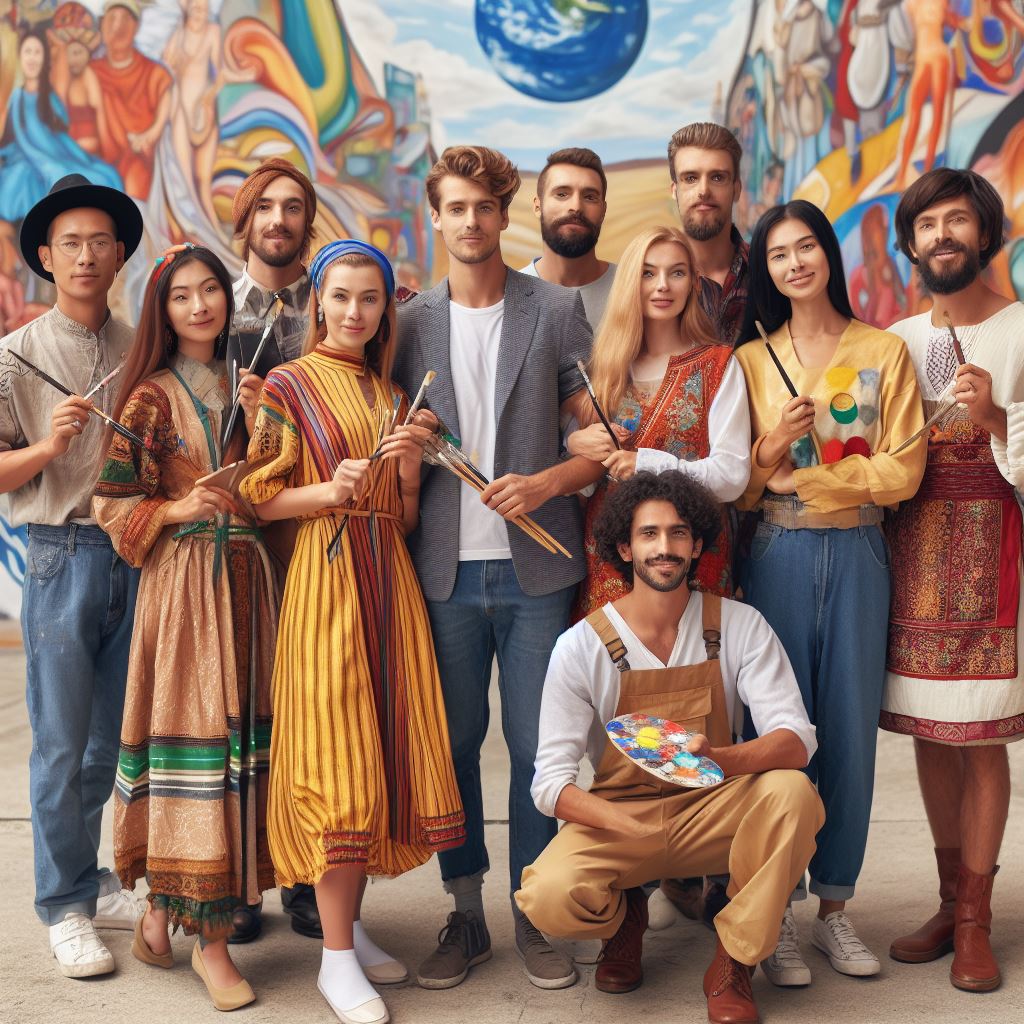Introduction
Pop culture refers to the prevailing cultural elements, such as music, fashion, and movies, that shape society.
Graphic design trends, on the other hand, represent the popular styles and techniques used in design.
Understanding the relationship between pop culture and graphic design trends is essential in comprehending how societal influences shape artistic expressions.
Influence of pop culture on graphic design in the US
Firstly, it allows us to analyze how cultural shifts impact the evolution of design.
Secondly, it provides insights into the preferences and tastes of the target audience, enabling designers to create impactful visuals.
Lastly, it helps us understand the societal context in which design trends emerge and shape consumer behavior.
This blog post will delve into three main points.
Firstly, it will examine the historical influence of pop culture on graphic design trends in the US.
Secondly, it will analyze the impact of technology and social media on the dissemination of popular culture and subsequently on graphic design trends.
Lastly, it will discuss the future prospects for graphic design trends, considering the ever-changing nature of pop culture.
In general, understanding the connection between pop culture and graphic design trends is vital in creating visually appealing and impactful designs.
By exploring the historical influence, technological advancements, and future prospects, designers can stay relevant in a rapidly evolving cultural landscape.
Stay tuned for the upcoming sections, where we explore these topics in more detail.
Historical Perspective: Evolution of US Graphic Design Trends
In order to understand the influence of pop culture on US graphic design trends, it is important to have a historical perspective on the development of graphic design in the US.
This section will provide a brief overview of the development of graphic design in the US, explore influential design movements throughout history, and identify key factors that shaped graphic design trends.
Brief overview of the development of graphic design in the US
- Graphic design in the US had its roots in the late 19th century, with the rise of the Industrial Revolution.
- The proliferation of printing technologies enabled the mass production of graphic materials.
- The early 20th century saw the emergence of graphic design as a distinct profession, with the founding of design schools and organizations.
- Designers began to create works that integrated art and technology, emphasizing functionality and visual communication.
- Advancements in technology, such as the introduction of computers, revolutionized the graphic design industry in the latter half of the 20th century.
Influential design movements throughout history
- The Arts and Crafts movement of the late 19th century advocated for the revival of traditional craftsmanship in design.
- The Bauhaus movement, founded in 1919, focused on the integration of art, craft, and technology.
- The Swiss Style, also known as the International Typographic Style, emerged in the 1950s and emphasized simplicity, clarity, and objectivity.
- The psychedelic design movement of the 1960s was characterized by vibrant colors, swirling patterns, and mind-altering visual effects.
- The postmodern movement challenged the strict rules of modernism and embraced a more eclectic and playful approach to design.
Key Factors That Shaped Graphic Design Trends
- The influence of fine art movements, such as Abstract Expressionism and Pop Art, played a significant role in shaping graphic design trends.
- The development of new technologies, such as the internet, digital imaging, and social media, has greatly influenced the way designers create and distribute their work.
- The rise of consumer culture and the increasing importance of branding in business have also impacted graphic design trends.
- The globalization of design has led to the incorporation of diverse cultural influences in graphic design practices.
- Pop culture, with its ever-changing trends and mass appeal, has a significant influence on graphic design, as designers often draw inspiration from popular music, movies, fashion, and other forms of entertainment.
Basically, the evolution of US graphic design trends is intricately connected to historical developments, influential design movements, and key factors such as technology, consumer culture, and pop culture.
By understanding the historical perspective of graphic design, we can better appreciate the impact of pop culture on the ever-changing trends in this dynamic field.
Read: Future of Photography: Predictions for the Next Decade in the USA
Understanding Pop Culture
Pop culture refers to the popular and prevailing cultural elements, including ideas, expressions, beliefs, activities, and products, that exist within a society.
It encompasses various forms of media, such as music, movies, television, fashion, sports, and technology, which are consumed and enjoyed by the masses.
Pop culture reflects the current interests, attitudes, and values of a particular society or community.
In today’s fast-paced world, pop culture plays a significant role in shaping society and influencing individual’s preferences and behaviors.
It is a dynamic and ever-evolving phenomenon that has a profound impact on various aspects of life, including art and design.
One of the areas where pop culture exerts its influence is graphic design.
Graphic design, as an art form, is heavily influenced by the trends and styles that emerge from popular culture.
Designers often draw inspiration from the popular cultural phenomena that capture the attention of the masses.
There have been numerous instances where popular culture has sparked new trends in graphic design in the United States.
One such example is the rise of superhero movies and comic book culture, which has led to an increased demand for dynamic and visually striking designs.
This trend is evident in the use of bold colors, powerful typography, and vibrant illustrations that capture the energy and excitement associated with superheroes.
Similarly, the advent of social media platforms and the rise of internet culture have had a significant impact on graphic design trends.
Pop Culture’s Impact: Shaping Graphic Design Trends
The need to create visually appealing content for online platforms has led to the emergence of minimalist designs and the use of eye-catching visuals that can quickly grab the viewer’s attention amidst the sea of online content.
Moreover, music and fashion trends have also influenced graphic design.
For instance, the punk rock movement of the 1970s gave rise to a rebellious and raw aesthetic that found its way into album covers, posters, and other graphic design elements.
Similarly, the grunge movement of the 1990s popularized a distressed and gritty style, which has been widely adopted in graphic design.
Another noteworthy phenomenon is the influence of popular culture icons and celebrities on graphic design.
Celebrities such as musicians, actors, and athletes often become significant sources of inspiration for designers.
Their unique style, personality, and endorsement of products or brands can shape the visual language of design, making it more relatable and appealing to the masses.
In essence, pop culture is a powerful force that influences and shapes various aspects of life, including graphic design.
The ever-changing trends and phenomena in popular culture have a direct impact on the styles, aesthetics, and visual language used by designers.
By understanding and embracing pop culture, designers can create designs that resonate with the current societal interests and preferences.
Read: Photographers’ Rights: Understanding US Copyright Laws
The Relationship Between Pop Culture and Graphic Design
Pop culture plays a significant role in shaping the aesthetics and styles of graphic design.
The reciprocal relationship between graphic design trends and pop culture creates a dynamic and ever-changing landscape for designers to navigate.
1. Influence of Pop Culture on Graphic Design Aesthetics and Styles
Pop culture has a powerful impact on the development of graphic design aesthetics and styles.
It influences the visual language used in design, including color palettes, typography, and imagery.
One example is the influence of music and album cover art on graphic design.
Throughout history, iconic album covers have set the stage for design trends, such as the psychedelic artwork of the 1960s or the minimalist designs of the 2000s.
Transform Your Career Today
Unlock a personalized career strategy that drives real results. Get tailored advice and a roadmap designed just for you.
Start NowSimilarly, movies and television shows have a profound effect on graphic design.
The popularity of certain films or TV series can inspire designers to create visuals that capture the essence of these cultural phenomena.
2. Reciprocal Relationship Between Graphic Design Trends and Pop Culture
The relationship between graphic design trends and pop culture is reciprocal.
Graphic designers often reflect and respond to the current cultural landscape through their work.
For instance, the rise of social media platforms like Instagram and TikTok has resulted in an increased demand for visually appealing content.
As a result, graphic designers are constantly adapting their styles to meet the expectations of these platforms and the audiences they attract.
Conversely, graphic design trends can also influence pop culture.
Memes, for example, often rely on clever graphic design techniques to convey humor or commentary.
These memes can quickly spread and become part of the cultural zeitgeist, shaping popular opinion and influencing the course of pop culture.
3. Case Studies: How Pop Culture Elements Shape US Graphic Design Trends
Several case studies demonstrate how specific pop culture elements have shaped US graphic design trends.
The rise of hip-hop music in the 1980s brought forth a new wave of bold and expressive typography, reflecting the energy and attitude of the genre.
Graffiti-inspired lettering and street art aesthetics became prominent in graphic design during this era.
The emergence of video games as a mainstream form of entertainment also left its mark on graphic design.
Pixel art, inspired by the visuals of early video games, has become a popular style in contemporary design, referencing nostalgia and gaming culture.
Additionally, the influence of fashion trends on graphic design is undeniable.
High-end fashion brands often collaborate with graphic designers to create visually striking advertising campaigns, merging the worlds of fashion and design.
In short, pop culture has a profound influence on the aesthetics and styles of graphic design.
The reciprocal relationship between graphic design trends and pop culture continuously shapes the visual landscape, creating a dynamic and ever-evolving field.
Read: Nature & Landscape Photography: Best Locations in the USA

Examples of Pop Culture Influencing US Graphic Design Trends
In this section, we will explore how various elements of popular culture, including music, film, television, and fashion, have significantly impacted graphic design trends in the United States.
Through an analysis of iconic images, artwork, advertising campaigns, and branding strategies, we will examine the profound influence of pop culture on the world of graphic design.
1. Impact of Music on Graphic Design
Music has played a crucial role in shaping graphic design trends.
Album covers, concert posters, and music videos have become powerful forms of visual expression.
The psychedelic art of the 1960s, influenced by bands like The Beatles and Pink Floyd, introduced bold colors, intricate patterns, and surreal imagery.
Similarly, the punk rock movement of the late 1970s and early 1980s embraced a raw and rebellious aesthetic, often depicted through DIY graphics and provocative imagery.
The iconic logo of the Sex Pistols, designed by Jamie Reid, became a symbol of punk culture and continues to influence graphic designers today.
2. Influence of Film and Television on Graphic Design
Film and television have been powerful sources of inspiration for graphic designers.
Movie posters, title sequences, and promotional material have shaped design trends in countless ways.
The iconic artwork of Saul Bass, known for his collaborations with Alfred Hitchcock, revolutionized film title sequences and introduced dynamic visual storytelling.
Television shows have also had a significant impact on graphic design aesthetics.
The opening credits of shows like “Stranger Things” and “Game of Thrones” have sparked a revival of retro-inspired designs, reminiscent of the 1980s and fantasy genres, respectively.
These visuals have influenced advertising campaigns and branding strategies, creating a nostalgic appeal for audiences.
3. Fashion’s Influence on Graphic Design
Fashion trends have always influenced graphic design, and vice versa.
The rise of streetwear and fashion collaborations with graphic designers have resulted in a fusion of styles and aesthetics.
Logos and typography from clothing brands like Supreme and Off-White have become iconic and synonymous with contemporary design trends.
The fashion industry’s use of graphic elements, such as patterns, colors, and textures, often finds its way into graphic design.
Designers incorporate fashion-driven concepts into their work, allowing for a dynamic interplay between the two creative fields.
4. Advertising Campaigns and Branding Strategies
Advertising campaigns and branding strategies have long been influenced by popular culture.
Brands often tap into current trends to connect with their target audience.
For example, Coca-Cola’s iconic “Share a Coke” campaign personalized their bottles with popular names, reflecting the cultural phenomenon of personalized products.
Moreover, brands frequently collaborate with pop culture icons to create compelling campaigns.
Nike’s partnership with athletes like Michael Jordan and Serena Williams not only promotes their products but also aligns their brand with the influence and success of these cultural icons.
Showcase Your Business Today
Reach thousands of readers actively exploring professional services. Publish your business profile and grow your audience now.
Publish NowThe influence of pop culture on US graphic design trends cannot be overstated.
Music, film, television, and fashion have all played a significant role in shaping aesthetics, styles, and visual communication.
From album covers to advertising campaigns, popular culture continues to inspire and inform the world of graphic design.
Read: US-based Photographers Who Changed the Game: A Tribute
Critiques and Limitations
In order to fully understand the influence of pop culture on US graphic design trends, it is important to evaluate both the positive and negative aspects of this influence.
Positive and negative aspects of pop culture’s influence on graphic design
On one hand, pop culture can have a positive impact on graphic design trends.
It provides designers with a constant source of inspiration, allowing them to stay current and relevant.
The vibrant and dynamic nature of pop culture can push designers to experiment and innovate, resulting in fresh and exciting designs.
Pop culture also has the power to connect with larger audiences.
By incorporating elements of popular trends, designers can create designs that resonate with people in a meaningful way.
This can help to create a sense of cultural identity and promote inclusivity.
However, there are also limitations and critiques to consider.
One of the main concerns is the potential for homogeneity in design.
Pop culture can sometimes lead to a lack of diversity in design trends, as designers may feel pressured to conform to popular styles and aesthetics.
This can result in a lack of originality and creativity in the industry.
How limited exposure to diverse design influences can lead to homogeneity
When designers are primarily exposed to pop culture influences, they may unintentionally create designs that all look similar.
This can be detrimental to the overall evolution and progress of graphic design as a discipline.
Without exposure to diverse design influences, designers may struggle to develop their own unique style and voice.
It is important for graphic designers to seek out inspiration from a variety of sources outside of popular culture.
Exploring different art forms, historical movements, and cultural traditions can help designers broaden their aesthetic understanding and create more distinct and diverse designs.
Potential challenges faced by graphic designers due to the rapid evolution of pop culture
The rapid evolution of pop culture can pose challenges for graphic designers.
Trends and styles can change quickly, making it difficult for designers to keep up with the latest demands and expectations.
This can create a constant pressure to stay relevant and innovative.
Designers may also find themselves navigating ethical dilemmas when incorporating elements of popular culture into their designs.
They must strike a balance between drawing inspiration from popular trends and avoiding appropriation or exploitation of cultures or communities.
Additionally, the fast-paced nature of pop culture can sometimes lead to superficial and short-lived design trends.
This can result in designs that lack enduring value or meaning. It is crucial for designers to critically evaluate the longevity and significance of the trends they incorporate into their work.
In fact, while pop culture can serve as a valuable source of inspiration and connection in graphic design, it is important to critically evaluate its influence.
Designers must be mindful of the potential for homogeneity, seek out diverse influences, and navigate the challenges posed by the rapid evolution of pop culture.
By doing so, they can ensure that their designs are not only visually appealing but also meaningful and innovative.
Conclusion
This blog post focused on the influence of pop culture on US graphic design trends.
We discussed several main points, highlighting the ongoing and dynamic relationship between pop culture and graphic design trends in the US.
It is evident that pop culture plays a crucial role in shaping the field of graphic design.
From music and fashion to films and social media, the trends and aesthetics produced by popular culture deeply impact graphic design.
By staying up to date with pop culture, graphic designers can effectively communicate with their target audience and create relatable and visually appealing designs.
Failure to recognize and embrace the influence of pop culture may result in outdated and disconnected designs.
It is important for graphic designers to be aware of the evolving nature of pop culture and its impact on design trends.
By constantly exploring and studying current and emerging pop culture phenomena, designers can remain at the forefront of their field and deliver designs that resonate with their audience.
Generally, acknowledging and understanding the influence of pop culture is crucial for graphic design professionals.
The dynamic nature of this relationship requires designers to continuously adapt and evolve their designs to stay relevant and appeal to their target audience.
By staying in tune with pop culture, designers can create captivating and influential designs that shape and reflect our society.
[E-Books for Sale]
The Big Book of 500 High-Paying Jobs in America: Unlock Your Earning Potential
$19.99 • 500 High-Paying Jobs • 330 pages
Explore 500 high-paying jobs in America and learn how to boost your career, earn more, and achieve success!
See All 500 High-Paying Jobs of this E-Book
1001 Professions Without a Degree: High-Paying American Jobs You Can Start Now
$19.99 • 1001 Professions Without a Degree • 174 pages
Discover 1001 high-paying jobs without a degree! Unlock career tips, skills, and success strategies for just $19.99!



